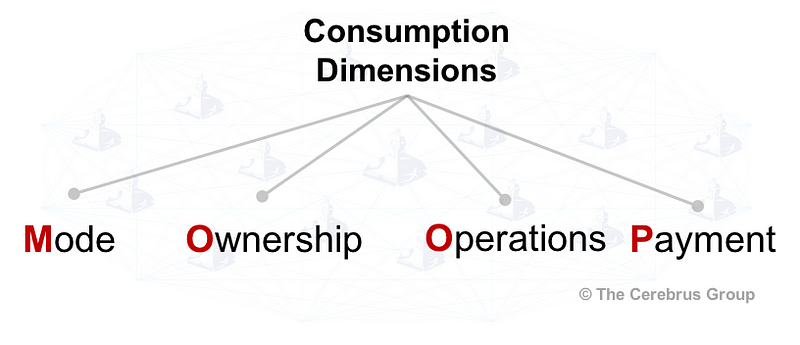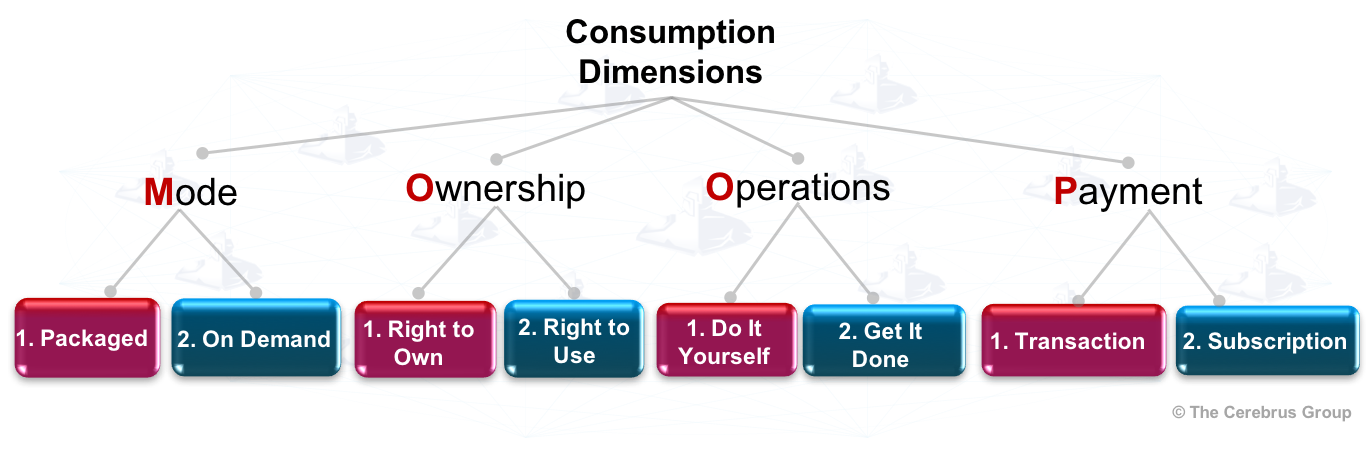For years we have been hearing about the virtues of IoT and specifically how Industrial IoT (IIoT) is the cure for inefficient machine maintenance and unplanned downtime. While all that is true, if zero-downtime (“ZDT”) was such a pain, why aren’t we all rushing to get connected and drive maintenance costs down and uptime up? Granted, quite a few of us have been doing it. But really, is that all we can come up with when we connect industrial machines pervasively and do fabulous data processing from cloud to edge and everywhere in between? Plain-old maintenance?
If connectivity to improve existing business operations is the sole purpose of IIoT, aren’t we quietly suffocating inside the dilemma-filled innovator’s basement? Can we reimagine the killer app or the killer product? Luckily, we can. All we need to do is take a consumption-centric view of product strategy.
IoT enables us to take a consumption-centric view to creating new offerings
Consumption-centric Product Strategy
Historically we built products with a technology-centric view. For example, in the IoT world it amounted to thinking about how to integrate sensors and computers in our largely electromechanical products; how to connect them with the plethora of communication mechanisms available to us (3G, LoRa…); how data was exchanged etc. All that is needed. But that is still thinking of the offer from a technology-centric lens, not a consumption-centric lens. Kindle did it.
IoT Killer App and Kindle
Kindle didn’t subject us to worrying about connectivity, subscription to a wireless plan, or maintenance. Buy a digital book, read it, or buy a subscription and keep reading. Simple enough, but how shall we do it in our industrial world?
There are two ways to reimagine your connected products in a consumption-centric manner: 1) Change the consumption model of your existing product OR 2) Offer a new product or service via your connected product
The former is like offering a robot-as-a-service instead of selling a robot outright. The latter is like selling site-security for a warehouse and using robots to deliver it, or like delivering a book over a Kindle. Kindle isn’t the IoT product. It is a mere delivery mechanism.
Reimagining Offers: Dimensions of Consumption
To reimagine your offerings for a connected world, think about these dimensions of consumption for your offer, any offer. The following graphic illustrates this:

The dimensions convey the following:
- Mode: How the end consumer or user gets your product: it comes in a package, comes as a service on-demand, comes digitally, delivered as audio etc.
- Ownership: Whether they chose to own your product or buy rights to use when needed. e.g. lease vs. buy
- Operations: Whether they operated it themselves (“self-driven”) or had someone else operate it for them (“chauffer-driven” or vendor-managed vs. self-managed)
- Payment: Did they pay to use each time or subscribe to it?
The simple variations under M-O-O-P dimensions are shown below:
Let’s mix and match the above and see how existing offerings in the market use these dimensions:
- Leased Car: Mode 1 (Packaged), Ownership 2 (leased for term), Operations 1 (you are driving it), Payment 2 (periodic payments over term). i.e. M1-O2-O1-P2 consumption pattern.
- Lyft (since it is politically incorrect to use Uber as example these days): M2-O2-O2-P1 consumption pattern.
- Connected Robot for Zero Down Time: M1-O1-O1-P1 pattern. Assumed capex spend and managed by the enterprise owner. As ho-hum as you can get. No killer app here! (I suppose the robot can’t be a killer app, lest it violates the laws of robotics.)
- Cloud computing: M2-O2-O2-P1 pattern. Assuming it’s pay-as-you-use pricing for Infrastructure-as-a-service (IaaS).
…and so on and so forth for any product you analyze. This pattern of transformation is an easy key to re-vector your business model.
Killer Business Models, Not Killer Apps
Last week I came across a robotics startup that offers a site-security solution based on robots (like a monthly subscription to ADT or Brinks for home security in the US). So it’s not killer apps that are coming, but killer business models and killer solutions.
Shouldn’t we at least march towards making our products more consumption-centric, if not start delivering new services on top of our existing products? Isn’t it time to get beyond the predictive-analytics-for-maintenance cliché and reimagine our offerings before someone else beats us to it? Thoughts?
[First published at medium.com/cerebrus]

